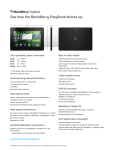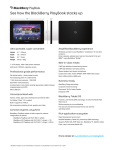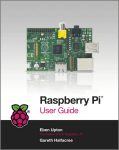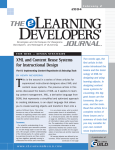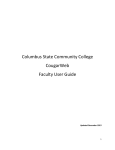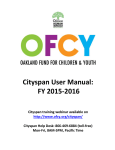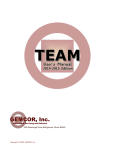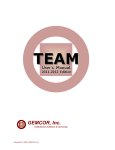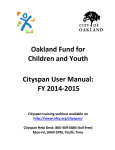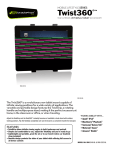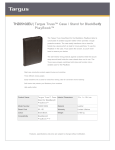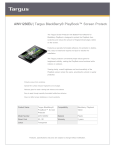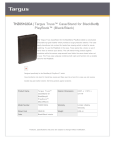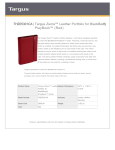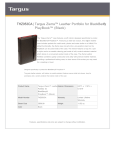Download Wiley BlackBerry PlayBook Companion
Transcript
1 BlackBerry PlayBook Companion MA TE RI What Is a BlackBerry PlayBook? AL Chapter One In this chapter: Walk around the Hardware D ++ ++ ++ ++ CO PY RI GH TE Walk around the OS Pricing, Availability, and Models Comparison with Other Tablets 2 BlackBerry PlayBook Companion C anadian-based Research In Motion (RIM) rolled out the first BlackBerry device in 1999, and since that time it has focused on providing powerful messaging devices that concentrate on enterprise security. RIM has many compelling smartphones available today, with the majority sporting a physical QWERTY keyboard. To help extend the reach of the BlackBerry from the conference room to your living room, RIM released the BlackBerry PlayBook tablet device April 19, 2011. The PlayBook is quite a departure from the QWERTY smartphones they are known for, but as you read in this book, you’ll discover the PlayBook retains the essence of BlackBerry while offering compelling consumer functionality. The PlayBook is a fantastic piece of hardware that offers unique experiences when compared to other tablets such as the Apple iPad, Motorola Xoom, and Samsung Galaxy Tab. Walk around the Hardware The two most common sizes of tablets today come with displays that are either 7 inches or 10 inches. To make the PlayBook a device that people can carry in their purses, jacket pockets, and with them all the time, RIM went with the smaller 7-inch form factor (see Figure 1-1). As a consumer who has used both sized devices for more than a year, the 7-inch form factor definitely makes the device one that is more likely to be used outside of the home or office. Figure 1-1 RIM BlackBerry PlayBook Chapter One: What Is a BlackBerry PlayBook? Before exploring the device and understanding all the hardware parts, take a look at a list of the specifications: ++ 7-inch LCD capacitive touch screen display, with 1024x600 pixels resolution (WSVGA) ++ ++ ++ ++ ++ QNX-based BlackBerry Tablet OS ++ ++ ++ ++ ++ ++ ++ ++ ++ ++ ++ 1 GHz dual-core processor 1GB RAM Integrated storage options of 16GB, 32GB, and 64GB Dual HD cameras capable of 1080p recording: ++ ++ 5 megapixel rear-facing camera 3 megapixel forward-facing camera Stereo speakers Micro HDMI video output port 802.11 a/b/g/n Wi-Fi radio Bluetooth 2.1 + EDR radio Integrated GPS receiver 5300 mAh battery Micro USB port for desktop connection and charging Accelerometer 6-axis motion sensing gyroscope Digital compass (magnetometer) Dimensions: ++ ++ ++ ++ Width: 7.6 inches (194 mm) Height: 5.1 inches (130 mm) Depth: 0.4 inches (10 mm) Weight: 15 ounces/0.9lb (425 grams) When you hold the PlayBook in your hands, you will be amazed that RIM crammed all these great parts into such a sleek and slim form factor. 3 4 BlackBerry PlayBook Companion Front of the PlayBook The front of the PlayBook is dominated by the 7-inch resolution display with a black frame measuring approximately 18 mm around all four sides of the viewable area of the display. In addition to the display, you can find speakers, an LED/light sensor, and a forward-facing camera. WHERE ARE THE BUTTONS? There is not a single hardware or even capacitive touch button on the front of the PlayBook. Navigation is controlled by the touch screen and the surrounding frame that is gesturesensitive, as detailed in Chapter 3 (How Do I Navigate My PlayBook?). ++ Display: The display supports up to four-finger multitouch gestures, so you can manipulate objects in unique ways. The capacitive touch screen panel is the type used on modern touch display smartphones, so the bezel responds to your finger rather than a stylus pen. Your finger acts as an electrical conductor and results in a distortion of the screen’s electrostatic field, thus changing the capacitance and enabling you to navigate the display. The display supports up to 16 million colors. You can rotate the PlayBook in all four orientations, and the display reorients itself to match your movements, unless you select to lock it. Therefore you can enjoy both widescreen video content and also read in portrait orientation, which closely matches that of a paperback book. ++ Stereo speakers: Centered on either side of the display are high quality stereo speakers that enable you to turn your PlayBook into a portable media device without even needing to plug in headphones or external speakers (see Figure 1-2). ++ LED indicator/light sensor: Above the display you can find a small opening in the black frame for the combination notification LED and light sensor (see Figure 1-3). This LED glows red for 3–5 seconds when you power up the PlayBook. It also serves as the light sensor, so in darker environments the screen automatically dims, whereas in well-lit areas the sensor causes the display to brighten. Chapter One: What Is a BlackBerry PlayBook? ++ Forward facing camera: To the right of the notification LED, you can find the forward-facing 3 megapixel camera, as shown in Figure 1-3, capable of capturing high-definition video and images. This camera is primarily intended for video conferencing. Figure 1-2 Left stereo speaker grill Figure 1-3 Notification LED and front-facing camera 5 6 BlackBerry PlayBook Companion Top of the PlayBook Six openings and buttons are located along the top of the PlayBook, which are the following: ++ Dual microphones: About 3/4 of an inch in from each side of the top of the PlayBook you can find small holes that serve as openings for microphones, as shown in Figure 1-4. These microphones can record sound in videos, enable you to use the voice recorder application to make voice notes, capture your voice during video chat, and more. ++ 3.5 mm headset jack: A standard headset jack is on the right side of the top near the edge of the PlayBook (refer to Figure 1-4). ++ Power button: Use the small button with red coloring in the center to power on or off your device by pressing and holding, as shown in Figure 1-5. You can also tap it to turn off the display. SKIP THE POWER BUTTON FOR DISPLAY CONTROL After the launch of the PlayBook, reviewers slammed the device for the nearly flush Power button that was hard to press for display control. You need to press the Power button only once to turn it on; then you can simply use the display timer settings to control when it goes off. Then, simply swipe from the outside of the bezel on any of the four sides into the center to turn the display back on. Because this method saves just as much battery as turning the device off completely, a user rarely turns off her PlayBook so the small Power button is rarely a concern or issue. ++ Media control buttons: Centered at the top, just to the right of the Power button, are the Volume Down, Play/Pause, and Volume Up buttons (refer to Figure 1-5). The Play/Pause button works with the default music player, video player, and even third-party applications that use the application programming interface (API). For example, you can control your music with the Play/Pause button in the Slacker Radio and Podcasts applications. To control the volume, press the Volume Up or Down button repeatedly. The volume level appears in a pop-up in the center of the display, and there are 15 volume levels. If you hold down either one of the volume controls, it simply turns off the on-screen volume level display. Chapter One: What Is a BlackBerry PlayBook? Figure 1-4 Headset jack and microphone opening Figure 1-5 Power and media control buttons QUICK MUTE TOGGLE You can toggle the mute function on and off by simply pressing and holding the Play/Pause button. A red Speaker icon with a line through it indicates that mute is enabled and another press/ hold turns on the speakers at the level you had set previously. 7 8 BlackBerry PlayBook Companion CAPTURE SCREENSHOTS WITH THE VOLUME BUTTONS A favorite trick for those who write books, reviews, or provide feedback to developers is to capture a photograph of your computer screen. To capture what you see on your PlayBook display, simply press the Volume Up and Volume Down buttons simultaneously. Screenshots are captured as .JPG images with 1024 x 600 pixels resolution and are placed in the camera roll just like when you capture still photos with one of the PlayBook cameras. Bottom of the PlayBook The bottom has some labeling information on either side with three important ports. These are described in the following list: ++ Labeling: On the left side of the bottom is where you can find the integrated storage stamp designating which of the three available models (16GB, 32GB, and 64GB) you have. Labeling on the right side includes the manufacturer’s data. ++ HDMI port: A micro HDMI port enables you to connect to your PlayBook with a compatible cable to an HD TV or monitor and output your display to the big screen (see Figure 1-6). ++ Micro USB port: The micro USB port is used for both charging and data transfer and is standard in most modern smartphones, including your BlackBerry smartphone (refer to Figure 1-6). ++ Charging contacts: There is an opening with three small gold contacts that you can use with compatible accessories to charge up your PlayBook (refer to Figure 1-6). The BlackBerry Rapid Charging Pad and Rapid Travel Charger both connect to these charging contacts to power up your PlayBook. Figure 1-6 HDMI, micro USB, and charging ports Chapter One: What Is a BlackBerry PlayBook? Back of the PlayBook The back of your PlayBook is entirely coated in black soft-touch material, eliminating messy fingerprints like you see on glossy black plastic finishes (see Figure 1-7). Figure 1-7 Back of the PlayBook The soft-touch coating also helps you hold onto the PlayBook better. Only two things are on the back of the PlayBook: ++ BlackBerry logo: The BlackBerry logo is highlighted in shiny silver material and placed directly in the middle of the back. ++ Rear facing camera: The 5-megapixel rear-facing camera is centered near the top of the back of your PlayBook, as shown in Figure 1-8. As you can see, there is no flash with this camera. This camera is primarily used to capture photos and videos while using the large display as your viewfinder. Figure 1-8 Rear-facing 5-megapixel camera 9 10 BlackBerry PlayBook Companion Retail Box Contents The RIM BlackBerry PlayBook comes in an attractive retail package, and includes the following inside the box: ++ ++ ++ ++ ++ Neoprene sleeve/case with BlackBerry branding A/C charger with micro USB male end USB to micro USB cable Screen cleaning cloth Product warranty and safety brochures It is quite rare to find any type of case in the box with today’s mobile devices, so it is a nice touch to have the neoprene sleeve case, as shown in Figure 1-9, that provides some basic protection for the PlayBook. HDMI to micro HDMI cables do not come standard with the device so you need to purchase one from your local electronics retailer or online retailer to output your PlayBook’s display to a big screen via the micro HDMI port. Figure 1-9 Included neoprene slip case Walk around the OS In September 2010, RIM co-CEO Mike Lazaridis said, “RIM set out to engineer the best professional-grade tablet in the industry with cutting-edge hardware features and one of the world’s most robust and flexible operating systems. Chapter One: What Is a BlackBerry PlayBook? The BlackBerry PlayBook solidly hits the mark with industry-leading power, true multitasking, uncompromised web browsing, and high performance multimedia.” RIM created their BlackBerry Tablet OS using a base of QNX and focused on supporting developers with a number of design platforms. Introduction to QNX Neutrino Realtime Operating System (RTOS) The QNX Neutrino microkernel architecture that the BlackBerry Tablet OS is built upon has been in use for many years. Neutrino has been used in important system applications such as airplanes, trains, automobiles, medical equipment, the International Space Station, and the large core routers that run the Internet. Thus, the foundation for the BlackBerry Tablet OS is well proven and trusted. The microkernel architecture, as opposed to the monolithic kernel architecture, enables functions, drivers, and file systems to operate outside of the kernel space, in user space, and thus the entire system does not need to shut down if a part of the OS crashes. The QNX Neutrino-based platform focuses on stability and performance for essential functions, rather than customization or flashy visual effects. The PlayBook has wonderful graphics, fluid performance in games, and amazing support for applications, but the focus is on an experience that performs well. Neutrino also provides RIM with the capability to support a large number of diverse application development environments, as discussed in the following section. Development Environments Supported on the PlayBook The BlackBerry Tablet OS is Portable Operating System Interface (POSIX)compliant, which means a level of code portability exists between systems to support software interoperability so applications created now for the PlayBook will run on future BlackBerry smartphones that may be running a different variation of the OS. Playbook supports a number of SDKs and development environments, including the following: ++ BlackBerry Tablet OS Native Development Kit (NDK): Enables C/C++ application development with the highest level of performance and support for OpenGL graphics functions 11 12 BlackBerry PlayBook Companion ++ BlackBerry WebWorks SDK: Supports the HTML5 web development standard ++ BlackBerry Tablet SDK for Adobe Air: Supports development through Adobe Air ++ BlackBerry Java SDK and app player: Enables consumers to run apps in a secure “sandboxed” area ++ Android app player: Supports Android 2.3 apps In addition to these environments, the web browser on the PlayBook is built to run WebKit and Adobe Flash, so web apps can also be used on the PlayBook. Applications are submitted to RIM and then appear in the BlackBerry App World application store. BlackBerry Tablet OS Native Development Kit (NDK) The NDK is the optimal environment to use when developing for the PlayBook with applications that can take advantage of the advanced 2D and 3D support on the device and hardware-accelerated OpenGL ES 2.0. As stated in the RIM press release at launch, other features of the BlackBerry Tablet OS NDK enable developers to: ++ Take advantage of the QNX POSIX library support and C/C++ compliance for quick-and-easy application porting and for creating native extensions for both BlackBerry and Android applications. ++ Easily integrate device events such as gesture swipes and touch screen inputs. ++ Integrate the BlackBerry Tablet OS environment into existing code management and build systems using industry standard Eclipse CDT (C/C++ Development Tools). ++ Leverage work done in standard C/C++ to make it easier to bring applications to the BlackBerry Tablet OS. ++ ++ Find and fix bugs quickly with proven debug and analysis tools. Produce games using game development tools from Unity Technologies and Ideaworks Labs. Chapter One: What Is a BlackBerry PlayBook? Pricing, Availability, and Models As of the PlayBook launch, there are three BlackBerry Playbook models available to choose from, and all three of these models support Wi-Fi-only, with no integrated cellular data radio. The three options include: ++ ++ ++ 16GB for $499 32GB for $599 64GB for $699 In the United States, sales launched at Best Buy, Office Depot, OfficeMax, RadioShack, Staples, and through the RIM online store. RIM announced that models with integrated cellular data would be coming in the future that include support for WiMAX, HSPA+, and LTE network technologies. These models will be available from carriers, and it is likely that subsidized price offerings will be available, so you can purchase a PlayBook for less money up front (generally a $100 to $200 savings for tablets) with a 1-year or 2-year service contract and minimum monthly data plan. The following models will become available throughout the course of 2011: ++ ++ BlackBerry PlayBook with Wi-Fi 802.1 a/b/g/n (available now) ++ BlackBerry 4G PlayBook with Wi-Fi 802.11 a/b/g/n + LTE (Verizon and maybe AT&T) ++ BlackBerry 4G PlayBook with Wi-Fi 802.11 a/b/g/n + HSPA+ (T-Mobile, AT&T, and non-U.S. networks) BlackBerry 4G PlayBook with Wi-Fi 802.11 a/b/g/n + WiMax (Sprint network) Comparison with Other Tablets Although tablet devices existed before 2010, Apple launched its iPad line in April 2010 and has sold millions. Thus, every tablet launched since then is first compared to the Apple iPad, and you can take a look at how the PlayBook stacks up to it in the following section. Since then, Google has developed compelling tablet offerings running the Android operating system. The Motorola Xoom and Samsung Galaxy Tab are the best-selling Android tablets 13 14 BlackBerry PlayBook Companion that also compare well with the PlayBook. Tablets running HP’s webOS and many more Android tablets will also be launched in 2011. Apple iPad Apple launched the iPad 2 in March 2011 with 18 different models available, including the following: ++ ++ ++ ++ White or black 16GB, 32GB, or 64GB internal memory capacity Wi-Fi only AT&T or Verizon 3G cellular data radio plus Wi-Fi As detailed in the previous section, the RIM BlackBerry PlayBook launched with Wi-Fi-only models in 16GB, 32GB, and 64GB capacities and is priced exactly the same as the iPad 2 devices with the same memory capacities. Now take a look at some key differences in the specifications and features between the PlayBook and the Apple iPad: Table 1-1: iPad 2 versus PlayBook Specification Apple iPad 2 BlackBerry PlayBook Display size and resolution 9.7″ at 1024×768 7″ at 1024×600 Processor Apple A5 dual-core 1GHz ARM Cortex A9 dual-core 1GHZ Cameras <1 megapixel with 720p video 5 megapixel rear and 3 megapixel still capacity with 1080p video Adobe Flash No Yes Third-party apps More than 75,000 More than 2,500 Motorola Xoom The Motorola Xoom was the first Android 3.0 device, also known as Honeycomb. Android 3.0 was designed for the tablet form factor, and the Chapter One: What Is a BlackBerry PlayBook? Xoom launched in the United States from Verizon Wireless in February 2011. A Wi-Fi-only version started selling from various retailers in the United States and Canada in March 2011. The Xoom comes with 32GB of integrated memory and a microSD card slot for expanded storage. As of May 2011, the microSD card slot is not yet usable because a firmware update is required to enable it. The Verizon Xoom launched with support for 3G data at a price of $599.99 with a 2-year Verizon contract and minimum monthly data price. You could buy it without a contract for $799.99 as well. The Wi-Fi-only model sells for $599 and no contract is required. $599 IS A STANDARD PRICE The 32GB models of the Wi-Fi-only Apple iPad, Motorola Xoom, and BlackBerry PlayBook are all priced at $599, so price is taken out of the equation when evaluating which tablet device meets your needs. Now take a look at some key differences in the specifications and features between the RIM BlackBerry PlayBook and the Motorola Xoom: Table 1-2: Motorola Xoom versus PlayBook Specification Motorola Xoom BlackBerry PlayBook Display size and resolution 10.1″ at 1280×800 7″ at 1024×600 Processor NVIDIA Tegra 2 dual-core 1GHz ARM Cortex A9 dual-core 1GHZ Cameras 5 megapixel rear and 2 megapixel still capacity with 720p video 5 megapixel rear and 3 megapixel still capacity with 1080p video Adobe Flash Yes Yes Third-party apps More than 60 More than 2,500 15 16 BlackBerry PlayBook Companion Samsung Galaxy Tab The Samsung Galaxy Tab is available as a 7-inch form factor tablet with new, larger 8.9-inch and 10.1-inch models launching later in 2011. The Galaxy Tab was the first major Android tablet to challenge the iPad in the tablet market and sold quite well with more than 2 million reportedly sold between November 2010 and February 2011. The Samsung Galaxy Tab is available now from various mobile carriers around the world and also as a Wi-Fi-only model. If you are looking for a tablet that is smaller than the iPad, larger than Android tablets or HP webOS tablets, then the Samsung Galaxy Tab is the closest competitor to the BlackBerry PlayBook. It can be purchased for a subsidized price ranging from $199.99 to $249.99, with the requirement of a 2-year data contract. The unsubsidized price is $549.99. A Wi-Fi only model is available for $349.99. Now take a look at some key differences in the specifications and features between the RIM BlackBerry PlayBook and the Samsung Galaxy Tab: Table 1-3: Galaxy Tab versus PlayBook Specification Samsung Galaxy Tab BlackBerry PlayBook Display size and resolution 7″ at 1024×600 7″ at 1024×600 Processor ARM Cortex A8 1GHZ ARM Cortex A9 dual-core 1GHZ Cameras 3 megapixel rear and 1.3 megapixel still capacity with 720p video 5 megapixel rear and 3 megapixel still capacity with 1080p video Adobe Flash Yes Yes Third-party apps More than 100,000, not all tablet-optimized More than 2,500 A major difference between the available tablets is the number of applications available for the different platforms. The quantity isn’t as important as the quality, but more choices inevitably result in a better selection and higher quality to choose from. RIM is still in its infancy with the BlackBerry App World on the PlayBook because only limited developer tools were released by May 2011. As developers get the opportunity to use the native development Chapter One: What Is a BlackBerry PlayBook? kit (NDK), bring BlackBerry smartphone apps to the PlayBook, and update Android apps to work with the Android Player, you will have many more apps to choose from on the PlayBook. RIM also focused on bringing a desktop-class browser to the PlayBook so that the need for apps in many cases can be eliminated by accessing tools via the web browser. Related Questions ++ ++ How can I enjoy music through the stereo speakers? page 146 ++ Where can I find out more about third party applications available for the PlayBook? page 216 The PlayBook cameras look good, but how can I use them to capture photos and videos? page 188 17


















